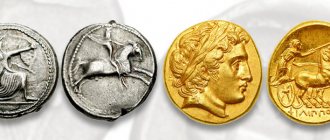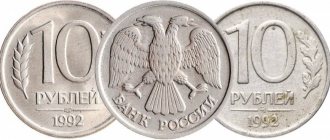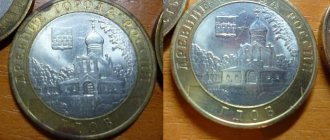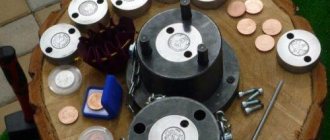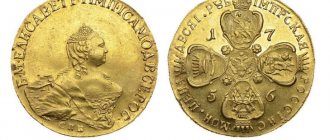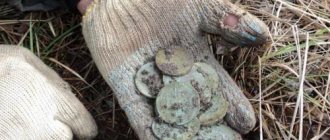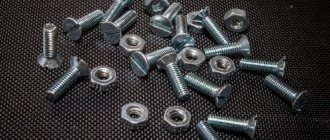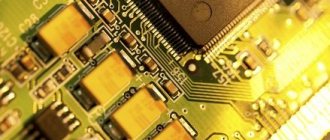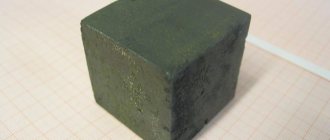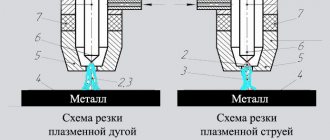Other articles Silver ten-kopeck coin of 1713 (Hermitage exhibition)
The first Russian coins appeared more than a thousand years ago, but for almost the entire period of history, the basis of the money supply was silver. In pre-Mongol Rus', instead of the word “money”, which has Tatar roots, the word “silver” was even used, which emphasizes the importance of silver in monetary circulation. During the period of feudal fragmentation, the first copper coins appeared - pulas, but they had very limited circulation. Gold coins arose under Ivan III, but for a long time they were reward coins and almost did not participate in circulation. And only under Peter I, gold and copper were firmly included in the monetary system, while copper coins played the role of change, and gold coins served more as a means of accumulation or for carrying out large financial transactions. The purchasing power of the coins slightly exceeded the cost of the metal, so the goal of the counterfeiters was not to make copies of the coins, but to underestimate the fineness, reduce the weight, and cut off the metal from the real coin. In the 20s of the 20th century, various alloys replaced expensive metals, and coins turned into coin-shaped banknotes. Gold and silver are now used only in the manufacture of collectible and investment coins. Palladium and platinum have also been added to them, but their share in the production of collectible coins is very insignificant.
Silver
The first silver coins “srebreniks” began to be minted under Prince Vladimir the Great around the 990s.
The period of independent Russian coinage did not last long, and already in the second half of the 11th century, the “Coinless Period” began, when silver bars were used as a means of payment. The issue of coins was resumed during the reign of Dmitry Donskoy; from that time on, there were coins of only two denominations - denga and polushka, all of them were silver. Under Ivan the Terrible, the first kopecks appeared, which became the basis of monetary circulation. In 1654-1655, the first ruble coins were issued, which were also made of silver, but the full circulation of the silver ruble had to wait another half century. Peter's monetary reform significantly transformed the appearance of coins, added many new denominations, but silver coins in denominations from a kopeck to a ruble (later from 5 kopecks to a ruble) were still the main ones. It was possible to completely abandon the use of precious metal in monetary circulation only under Soviet rule. The last silver coins date back to 1931 (10, 15 and 20 kopecks), fifty kopecks disappeared in 1927, and rubles even earlier - in 1924. Silver bullion coin
In 1977, for the upcoming Olympics, collectible silver coins of improved minting quality were issued; in subsequent years, the production of silver commemorative and anniversary coins was continued. Currently, several dozen types of collectible and investment coins are issued annually; they can be purchased in banks at a special price. The weight of such coins ranges from 15 grams to 5 kg.
| Parameter | Meaning |
| Color | Silver white |
| Chemical designation | Ag |
| Melting temperature | 960°C |
| Density | 10.5 g/cm3 |
| Mohs hardness scale | 2,7 |
Old Russian state (mid 9th - mid 15th centuries)
During this time period, not only metals, but also furs were used as money. Judging by the surviving historical information, in the 9th–10th centuries a warrior received 8–9 Kyiv hryvnia per year. It is worth recalling that the hryvnia is a silver bar. One such Kiev hryvnia corresponded to more than two hundred silver dirhams.
In addition, clippings of silver dirhams were in circulation in Rus'. For example, one such cutting weighing 1.04 grams, circulating in the lands of Northern Rus', was equal to 1/200 of a silver hryvnia.
Also, in addition to furs and silver, gold was also used as money.
Gold
Golden chervonets of Peter I (Hermitage exhibition)
The first Russian gold coins appeared at about the same time as silver coins - at the end of the 10th century, but their production had a very small volume, and under subsequent rulers it stopped altogether. Under Ivan III, the minting of gold grant coins began, which were awarded to outstanding architects, builders, and also for various merits. These coins were not a full-fledged currency, although they came into circulation from time to time. Since the era of Peter I, the gold coin has occupied a special niche in monetary circulation; 2-ruble coins and chervonets coins without indicating the denomination are made from gold. Under Elizaveta Petrovna, 5 and 10 rubles appear. The gold coin remained a hard currency, an alternative to constantly depreciating banknotes. During the Civil War, they (especially the Nikolaev 10 rubles) had a high exchange rate among the population and were in great demand. In 1923, a large edition of Soviet gold chervonets was issued, the size and weight of which coincided with the Tsar's 10 rubles. Their goal was to reinforce the paper chervonets, which had a gold backing. The population did not receive such coins, and they were not accepted abroad because of Soviet symbols, so the issue was not continued, and the bulk of the circulation was melted down. In 1975-1982, new-made chervonets were issued with exactly the same images, but different dates; currently they serve as investment coins. Since 1977, in addition to collectible silver coins, gold coins have been minted. The production reached its greatest volume in 2010-2013, after which it began to decline. However, several types of gold coins are currently produced annually and can be purchased from banks at special prices. In addition to this, investment gold coins of UNC quality are issued, the cost of which is slightly lower than collectible ones.
| Parameter | Meaning |
| Color | Golden |
| Chemical designation | Au |
| Melting temperature | 1064.43°C |
| Density | 19.621 g/cm3 |
| Mohs hardness scale | 2,5 |
Coin metals. The oldest: gold, silver, copper
Ilya Leenson, Ph.D. chem. Sciences, Associate Professor, Higher Chemical College of the Russian Academy of Sciences
“Trinity Option” No. 1(245), January 16, 2022
Teacher:
I put a gold coin in nitric acid - will it dissolve?
Student:
Of course not, Mr. Teacher! After all, if it had dissolved, you would never have put it there! Old joke
Gold, as well as silver and copper, were the main metals used to mint coins for thousands of years. Gold is probably the first metal with which ancient man became acquainted. Gold has an attractive appearance, is not subject to corrosion and forms nuggets, sometimes quite large. Thus, in 1973, a gold nugget weighing 108.8 kg was found in California (USA). Since ancient times, coins have been minted from gold and its natural alloy with silver. electron in Greek
(Latin
electrum
), it contains 15 to 50% silver and is light yellow in color. The first coins in human history were issued from this alloy in the Lydian kingdom (7th century BC). The art of minting gold coins reached a high level in Ancient Greece.
Rice. 1.
Golden stater of the Macedonian king Philip II (359–336 BC)
In Egypt there once existed a very rich deposit, which was completely depleted in ancient times. The Romans mined gold in Spain, and mines in Germany and Austria-Hungary produced several tons of gold annually until the 19th century.
Rice. 2.
Gold ducat of the Bavarian king Maximilian I Joseph (1821) with the inscription “From the gold of the Danube”
Very rich gold placers were found in the 18th–19th centuries in Brazil, the USA, Australia, and other countries. For a long time, Russia did not have its own gold; coins were minted in small quantities from imported metal. Such, for example, is the very rare first Russian gold coin - the Zlatnik of Vladimir. Her image was placed on the 100-ruble gold anniversary coin in 1988.
Rice. 3
In the past, the denomination of coins corresponded to the value of the metal in them, so gold coins were small. The smallest gold coin was minted in South India at the end of the 18th - beginning of the 19th century; it weighed only 65 mg. The heaviest gold coin of the Russian Empire was minted in 1755 and had a face value of 20 rubles. and mass 33.14 g (sample 917).
Rice. 4.
This very rare 20-ruble coin of Elizabeth Petrovna was sold at auction for £1,550,000
Large 10-ruble gold coins for circulation were minted in Russia in small quantities from 1756 to 1763. They contained 15.18 g of pure gold. A heavier gold coin was minted in Russia in a small edition in 1876 at the request of one of the Grand Dukes, who gave out the coins as souvenirs. Such coins are called donative
(gift). Donative coin of the 88th spool standard (metric - 917) in denomination of 25 rubles. had a mass of 32.72 g. Slightly lighter (32.26 g) were also very rare 25-ruble souvenir coins minted in 1896 and 1908, as well as a coin with the unusual inscription “37 rubles 50 kopecks, 100 francs”, minted in 1902. It was planned to mass mint such coins for foreign payments (hence the “non-round” denomination in rubles), but it never took place.
In the first half of the twentieth century, gold coins in all countries ceased to be a means of payment and went out of circulation. In Russia, such coins were last issued in 1911. In 1923, gold chervonets were minted in the USSR, intended mainly for settlements with foreign countries. Copies of such coins (remakes) were minted in 1975–1981.
Rice. 5.
Gold coin “Sower”, a copy of the Soviet chervonets of 1923
Investment coins are minted in huge quantities. They are used as a way to invest money, and their price is close to the value of the gold they contain.
Rice. 6.
Investment coin “Victorious”
Since 1967, investment gold coins (krugerrands) began to be minted in the Republic of South Africa. They contain 1, ½, ¼ and 1/10 ounces of gold. The mass of all minted “krugers” amounts to tons!
Rice. 7.
Krugerrand. The coin features an image of Paul Kruger (President of South Africa from 1883–1900), an antelope and the inscription in Afrikaans and English “1 ounce of fine gold”
Investment gold coins are also minted in the USA (“Golden Eagle”), Canada (“Golden Maple Leaf”), Great Britain (“Britannia”), Australia (“Australian Kangaroo” and “Australian Nugget”), Austria (“Golden Philharmonic”) ), China (“Golden Panda”). Most of these coins have a four-nines fineness (999.9).
|
|
|
|
|
|
| Rice. 14 | |
In many countries, gold coins are minted in honor of an event (commemorative coins) or on the occasion of a significant date (anniversary coins). Especially many commemorative gold coins are dedicated to sporting events. Often these are real works of art. For example, 900-carat gold coins with a face value of 100 rubles are very beautiful. and weighing 17.28 g, released in the USSR in 1977–1980 and dedicated to the Olympic Games in Moscow.
Rice. 15
Countries of the world “compete” in issuing the largest and heaviest gold coin. In 2010, the Bank of Russia issued a coin weighing 5 kg for its 150th anniversary. Twenty times heavier is the Canadian coin issued in 2007 for the centenary of the Canadian Mint. In 2011, the Canadian coin was surpassed by the Australian mint, which produced a giant gold coin weighing over a ton (1012 kg), with a diameter of 80 cm and a thickness of 12 cm.
Rice. 16
The highest standard of gold coins is “five nines” (99.999% pure gold). Pure gold is quite soft, so such coins are packaged in a special blister that protects the coin from damage.
Rice. 17
The second coin metal from ancient times was silver. It also occurs in nugget form; the largest weighed many tons. Silver is easy to smelt from its ores. The denomination of silver coins for circulation, like gold coins, once had to correspond to the value of silver in them. There is 18 times more silver in the earth's crust than gold.
However, the ratio of the cost of gold and silver also depends on the availability of these metals and the demand for them. Thus, in Ancient Mesopotamia (8th century BC), gold was valued 13 times more expensive than silver. Approximately the same ratio was in Ancient Egypt and Greece. In the Middle Ages it ranged from 1:10 to 1:13, and in the 17th century it increased to 1:16 (silver became relatively cheaper).
The ratio of prices of silver and gold can be determined by the content of these metals in coins, and for Russia - also by personal and senate decrees. In the middle of the 18th century, the Au:Ag value ratio in Russian coins was 15.0 and remained virtually unchanged until the end of the 19th century, but at the beginning of the 20th century it increased to 23.2. It remained the same when the Soviet gold chervonets was issued in 1923, containing ¼ ounce of pure gold. It can be compared to the silver ruble of 1924 (18 g of pure silver). (Figures 18 and 19.) US gold and silver coins had similar Au:Ag ratios for many years. At the end of the 18th century it was 14.9, in the mid-19th century it was 16.9, and by the 1930s it had risen to 27.0. In recent decades, the price of gold has begun to rise rapidly. If in 1977 they paid $200 per ounce, then 40 years later it was six times more.
And the rapid development of electronics and color photography, which do not require a lot of silver, has greatly reduced the price of silver relative to gold. Thus, at the end of 2022, the price of gold on international markets was about $1,260 per ounce, and silver - $16. As you can see, the Au:Ag ratio is already close to 80!
Rice. 18
Rice. 19
In their pure form, gold and silver are too soft, but small additions of other metals (they are called alloys) give gold and silver coins sufficient hardness. Most often, gold and silver were alloyed with copper. This alloy is much harder than pure metal. Chemically pure gold is yellow in color. Red (i.e. red color) gives copper to gold. “Red gold” - an alloy of gold and copper in a ratio of 9: 1 - is used for minting coins.
The third coin metal was relatively cheap copper. It is quite hard, easily rolled into thin sheets, stamped well, which allows the finest details to be reproduced on coins, is quite resistant to corrosion, and has a good appearance. During stamping, copper coins acquire additional hardness. In the past, the value of copper in a coin also had to correspond to the face value. This is how huge copper money appeared - boards. For example, in Sweden under Queen Christina (1632–1654), the board corresponding to a 10-daler silver coin weighed 19.5 kg!
Russian boards were smaller; Thus, the copper ruble of 1725–1726 weighed “only” 1.64 kg (1/10 pood), half - 0.82 kg, half half - 0.41 kg, etc. The coins were special issues minted in a very small number of copies. However, copper coins produced in Russia from 1758 to 1810 (with a short break) in huge quantities also weighed a lot - more than 50 g!
Rice. 20.
Copper board - hryvnia
Obviously, silver coins “contained” less money than gold coins of the same mass, and copper coins - even less. Therefore, only rubles, fifty kopecks and half-fifty kopecks (25 kopecks) were minted from silver of the 900th standard (since 1886), from low-grade silver of the 500th standard - coins in denominations from 5 to 20 kopecks, and from copper - small coins. And if you put next to a small silver coin from 1810 weighing 1.2 g (diameter 1.5 cm) and a large and heavy copper coin from the same year weighing 51.2 g (diameter 4.5 cm), the difference between the cost of silver immediately becomes visible and copper. Similarly, for a small gold 10-ruble “Nicholas” coin weighing 8.6 g, you had to pay 10 ruble coins with a total weight of 200 g.
The large weight of copper money led to significant inconvenience. Here is a striking example. At the end of 1747, M.V. Lomonosov wrote his most famous ode, dedicated to the sixth anniversary of Elizabeth Petrovna’s accession to the throne. The lines from this ode are often quoted to the effect that “the Russian land can give birth to its own Platos and quick-witted Neutons.” The empress liked the praises to Elizabeth (however, corresponding to the genre of odes) so much that she ordered the author to be given 2000 rubles. - a huge amount for that time.
However, there was no silver in the treasury at that moment, and banknotes appeared only under Catherine II; I had to give the royal gift in copper: two carts of copper money were delivered to Lomonosov. It is not difficult to calculate their weight. According to a personal decree of 1730, coins worth 10 rubles were minted from 1 pound of copper (at that time these were dengi and half rubles). This means that 2000 “copper” rubles weighed 200 poods, or 3.2 tons! If Lomonosov had lived 150 years later, his award would have weighed “only” 640 kg, since since 1867 copper coins worth 50 rubles were minted from a pound of copper. And if two thousand ruble coins of those years had been found in the Elizabethan treasury, they would have weighed less than 52 kg.
Rice. 23.
“Lomonosov Award”: denga (1/2 kopeck) 1746; standard weight - 8.19 g
Rice. 24.
“Lomonosov Award”: half a coin (1/4 kopeck) 1746; standard weight - 4.1 g
And one more interesting fact regarding the value of metal in coins. In order not to carry huge masses of copper money across the Russian expanses, Catherine II in 1763 ordered the minting of small coins for Siberia from “local” copper mined at the Kolyvano-Voskresensky mine (near modern Novosibirsk). There was also a copper smelter and a mint there.
Rice. 25.
The circulation of this Anna Ioannovna ruble from 1734 was 2,460,699 pieces
Catherine was informed that the copper from this mine contained a natural admixture of silver (0.81%) and gold (0.036%) - even then chemistry in Russia was at its best. Their extraction from copper was unprofitable in those days, so it was decided to include the value of gold and silver in the value of Siberian copper money. Therefore, from one pound of Kolyvan copper, “Siberian” coins (from half a half to 10 kopecks) were minted for 25 rubles, while all-Russian copper coins were minted for only 16 rubles. Therefore, an ordinary Russian coin of those times weighs 51.19 g, and a Siberian one - 32.76, the difference is significant!
Rice. 26.
"Siberian" 2 kopecks 1764 with the image of sables
Copper
5 kopecks 1802 (Hermitage exhibition)
Copper coins - pulas - were made in Novgorod and Tver back in the 15th century; they were small and had an irregular shape, just like silver coins of that time. It is still unknown exactly in what ratio they were equated to silver; there are different opinions: from 20/1 to 150/1. With the unification of Rus', local types of coins disappeared, and with them the pools. Copper monetary circulation was revived under Tsar Alexei Mikhailovich, when they tried to equalize coins made of silver and copper that were identical in size and weight. This caused a strong drop in the exchange rate of copper coins and the famous “Copper Riot”; the idea had to be abandoned. Since 1700, the first full-fledged copper coins of a round shape were issued, which, compared with the silver “scales” that circulated in parallel with them, were significantly ahead of their time. The high quality of copper coins made it possible to partially introduce copper into circulation and replace scarce silver with it. For more than 200 years, copper coins served as change, the denominations were low: from half a half to 5 kopecks (sometimes a coin with a denomination of 10 kopecks was produced). In 1924, when the Soviet ruble finally strengthened, copper coins in denominations of 1, 2, 3 and 5 kopecks (since 1925 - half a kopeck) came into circulation, but within two years they began to be replaced by more durable and cheaper bronze ones. In the modern history of Russia, a copper coin was also issued - 5 rubles of the 1997 model, which had a copper base and plating made of cupronickel alloy. Since 2009, they have been replaced by coins with a steel base, but copper ones can still often be found in circulation.
| Parameter | Meaning |
| Color | Golden pink |
| Chemical designation | Cu |
| Melting temperature | 1083.55°C |
| Density | 8.92 g/cm3 |
| Mohs hardness scale | 3 |
Russian state (15th - 17th centuries)
During these times, the state monetary system developed and already consisted of the ruble, half, hryvnia, penny, kopeck, money, half money and pula. Despite this, silver continued to serve as the main metal used in trade and payment of salaries. The pools, in turn, were made of copper.
During the monetary reform of Elena Glinskaya, a standard appeared for the minting of Moscow money - “Moskovka” and “Novgorodka” - Novgorod money. Moreover, one “Novgorodka” corresponded to two “Moskovkas”. On the obverse of the Novgorod money, by the way, a horseman with a spear was depicted, which is why it was nicknamed “kopek”. From one silver hryvnia they were minted in quantities of 300 pieces with an average weight of 0.68 grams. Silver “Moskovki” weighed half as much - 0.34 grams. One hundred “Novgorods” constituted a Moscow counting ruble. Over time, the heavier penny pushed the money into the background.
One ruble was divided into half, hryvnia and altyn. Poltina was half a ruble, the hryvnia included 20 money, and the altyn included 6 money.
Kolyvan copper
Siberian 10 kopecks (Hermitage exhibition)
When gold and silver were isolated from the copper ore of the Kolyvan deposit in Altai in the second half of the 18th century, the resulting copper remained with a small admixture of the precious metal. It was impossible to visually distinguish Kolyvan copper from ordinary copper, but the gold content in it reached 0.01% and about 0.8% silver. The estimated price of the metal was 24.24 rubles per pound, while the cost of ordinary copper was 6 rubles per pound. The President of the Mint Department, I. Schlatter, proposed minting special “Siberian” coins from this copper, which would be one and a half times lighter than ordinary ones. For the issue, the Suzunsky Mint is created near modern Barnaul. Minting lasted from 1763 to 1781, denominations from half a half to 10 kopecks were issued. The coins had completely different images and the coat of arms of Siberia. Just a few years after the start of production, the technology for separating metals was modernized, and the content of precious impurities became completely insignificant, but the weight of Siberian coins was not increased. The end of production was a consequence of rampant counterfeiting; criminals made coins from ordinary copper, which was four times cheaper, while receiving huge profits.
Unusual materials for coins
Over the history of the existence of coins, it became clear that banknotes can be made from precious and non-precious metals, as well as from unusual materials. For example, due to large shortages during World War II, Manchukuo began to issue money from cardboard impregnated with zinc chloride. Such money did not last long, but at that time there was no choice.
rice. 3. Porcelain coins
During 1914-1924, porcelain coins were issued in Germany, which was also an unusual solution. But the African state of Congo relatively recently, in 2005 and 2006, issued coins made of wood and also glass. And in Transnistria, in modern times, money is issued from polymer material. According to some experts, such technology has every reason to gain widespread acceptance.
Platinum
Platinum coin with a face value of 12 rubles (Hermitage exhibition)
At the end of the reign of Alexander I, significant deposits of a metal unknown at that time - platinum - were found in the Urals. With the coming to power of Nicholas I, the minting of platinum coins in special denominations was organized: 3, 6 and 12 rubles. The fact is that, to save money, the same equipment and presses were used in the manufacture of circles as in the manufacture of silver blanks. The estimated cost of platinum was 12 times higher than silver, and its density was 2 times higher. Therefore, 12 rubles had the size of 1 ruble, 6 rubles 50 kopecks, and 3 rubles 25 kopecks. Coins were produced en masse in 1828-1845, but again counterfeiters, who used ordinary silver as a raw material, became an obstacle. Moreover, there were cases of fraud when regular silver coins were issued instead of platinum coins (it was easy to confuse them in the dark). After the end of the issue, all the platinum stored in the treasury and the coins that were collected from the population were sold to England. The revival of platinum coinage occurred already in Soviet times; these were collector's issues of improved quality, dedicated to various events. Production was discontinued in 1995.
| Parameter | Meaning |
| Color | Steel gray |
| Chemical designation | Pt |
| Melting temperature | 1769°C |
| Density | 21.5 g/cm3 |
| Mohs hardness scale | 4,3 |
Industrial production of coins in a factory
Stamp molding and engraving
When a new coin was introduced into service, sculptors at the mint developed a set of designs. Once one specific sketch is approved and refined, the sculptor creates a clay model. The model can be anywhere from three to twelve times larger than the real coin.
Plaster is poured over the clay model to create a negative or reverse plaster model. The words of the inscriptions are carved into the plaster in a mirror order. The sculptor repeats this process several times until the plaster model is perfect.
Next, a durable rubber mold is made by pouring epoxy resin into a plaster mold. An epoxy mold is mounted onto the transmitter. At one end of the transmitter-engraver, a stylus traces the epoxy mold. As the stylus is moved, the ratio bar in the middle of the engraver reduces the design to the actual size of the coin. This reduced size communicates with a carbide tool at the opposite end, which then cuts the structure into a steel blank. This produces a stamp which the sculptors examine and remove any imperfections.
Creating work stamps
The heat-treated metal is placed under a computer-controlled lathe where it is smoothed and polished into a precisely measured piece. The main hub is pressed into the die. The result is called the "master stamp". The main die is used to create working hubs and working matrices. The master hubs and matrices are then placed into storage.
Punching blanks
A suitable spool of metal is fed through an extinguisher, which knocks out circular discs corresponding to the dimensions of the coin to be minted. Workpieces are cut at a speed of 400 strokes per minute. The remaining scrap metal is crushed and recycled for future use.
Annealing and polishing of workpieces
The blanks undergo another annealing process and are then placed in industrial washers and dryers. The lubricants used in these various processes cause the workpieces to stain and oxidize. The blanks are then placed in rotating tanks or barrels filled with an acidic pickling agent. After this procedure they become polished.
Sorting coin blanks
The blanks are sifted through a "riddler", a metal sheet equipped with holes that correspond to the exact size of the specific coin to be minted. In this way, defective coin discs are selected.
Coin defeat
Ideal blanks, stamped with patterns and inscriptions, are transferred by a conveyor belt to a case for pressing. A steel collar is inserted into a press around one of the dies. The reverse side cube is loaded into the upper arm of the press. Hundreds of tons of atmospheric pressure push the plug into the collar. At the same time, the top die is pushed into the collar and onto the form. The impact creates an impression on both sides of the workpiece. The press releases the newly measured coin and it moves along a conveyor belt to the inspection line.
In some cases, the collar is grooved to create ribbed edges on the coin. Otherwise, the grooves are created after impact, on a tool called a digging mill. Press sizes range from a single container to units that mark four coins at a time. Single-cycle presses typically mark 400 coins per minute, with loads up to 180 tons. Several presses can produce 120 coins per minute under a pressure of 250 tons.
Checking and sorting
The press operator inspects each batch of new coins using a magnifying glass. The coins are moved through another riddler, who disassembles the discs that have become warped or dented during the astonishing process.
Counting and packing
An automatic counting machine dispenses a predetermined number of coins and drops them into large canvas bags. The bags are sewn shut, loaded onto pallets, and then moved by forklifts to storage facilities.
Palladium
Palladium is very similar to platinum, but has a much lower density, close to silver. Palladium coins were produced only in 1977-1995, these were collector's issues of improved quality PROOF and Uncirculated.
| Parameter | Meaning |
| Color | Silver white |
| Chemical designation | Pd |
| Melting temperature | 1554°C |
| Density | 12.02 g/cm3 |
| Mohs hardness scale | 4,8 |
Collector's interest
Nowadays, bimetallic 10 ruble coins are popular as an item for active purchase and resale among collectors. This fact partly explains the fluctuation in prices for coins of different series. In general, their value is increasing, and in the future they will become a good investment.
The excitement is especially growing around private nuclear enterprises, which is due to their small number. Since the introduction of these coins, the price has increased 10 times, and the demand for them remains stable.
Experts rightly call this coin a domestic numismatic masterpiece. The demand for it among Russian collectors is high and significantly exceeds supply, far surpassing other bimetallic 10 ruble coins. Before the advent of private nuclear enterprises, their prices did not rise above 500-600 rubles. In the case of ChNP, we can safely talk about a real collectible phenomenon.
Copper-nickel alloys
Silver coins were replaced in 1931 by 10, 15 and 20 kopecks made of a new material - a copper-nickel alloy. As the name suggests, it is based on copper and nickel with the addition of a small proportion of other metals. There are different alloys, but they are all quite resistant to environmental influences and have a silver color. The copper content reaches 90%, but can be significantly less; the nickel content usually does not exceed 20%. From 1997 to 2009, coins of 1 and 2 rubles were made from nickel silver, and 25 rubles from 2011 from cupronickel. There was also a cupronickel insert for bimetallic 10 rubles until 2022. The most common types of copper-nickel alloy:
cupronickel - 68-93% copper, 5-30% nickel, up to 0.8% iron, up to 1% manganese;
nickel silver - 5-35% nickel, 13-45% zinc, the rest is copper; Monel - up to 67% nickel, up to 38% copper. Characteristics of cupronickel:
| Parameter | Meaning |
| Color | Silver |
| Alloy composition | 68-93% copper, 5-30% nickel, up to 0.8% iron, up to 1% manganese |
| Chemical designation | NiFeMn |
| Melting temperature | 1170°C |
| Density | 8.8-9 g/cm3 |
| Mohs hardness scale | 3-3,5 |
Main metal of coins of the Russian Federation
If we are talking about everyday items that have recently left the mint, then they are made of steel. It is an alloy of iron with the addition of carbon that is currently the basis for the production of negotiable banknotes of the Russian Federation. Considering that coin steel contains up to 1.7% carbon, we are talking about high-carbon steel.
To make coins wear-resistant and resist corrosion, they are plated. For the most recent issues of denominations below the ruble, this is brass. Ruble denomination coins are plated with nickel. All steel coins have pronounced magnetic properties. Above is a steel five made on a workpiece that erroneously avoided galvanizing.
Bronze
Bronze replaced the more expensive copper in Soviet-era currency. Another advantage of bronze is its higher resistance to aggressive environments. Bronze contains a large part of copper (up to 90%) and other metals (tin, aluminum, beryllium, silicon, lead). Depending on the metal it contains, bronze is called tin (or simply bronze), aluminum, etc. Bronze has a reddish-golden color, more yellow than pure copper. It quickly fades when exposed to air, forming a protective film that prevents further oxidation. The first bronze coins came out in 1926, using aluminum bronze. After 1957, the use of bronze in coin production ceased, and was replaced by a copper-zinc alloy. Since the 1990s, bronze has been used to make rings or inserts for bimetallic coins.
| Parameter | Meaning |
| Color | Golden yellow |
| Alloy composition | 75-90% copper, 10-25% tin (or aluminum, silicon, beryllium, lead) |
| Chemical designation | CuSn, CuAl, CuSi, CuBe, CuPb |
| Melting temperature | 930—1140° C |
| Density | 7.5-8.8 g/cm3 |
| Mohs hardness scale | 2,5-3 |
Combined coins (bimetallic)
Bimetallic coins
Combination coins are made from two materials, typically using brass and cupronickel alloys. By the way, the first bimetallic coin, the denomination of which was ten rubles, was issued in the USSR and put into circulation in 1991. The copy did not have the Soviet coat of arms, so it was minted in Russia until 1992.
To summarize, we can safely assure that it will be quite difficult to determine the composition of an alloy and metal without special knowledge in chemistry and numismatics, however, thanks to the World Wide Web, you can always find information that interests the reader and reveal the fascinating features of a particular alloy, as well as easily determine its components.
Brass
Brass differs from bronze in its lower copper content and the presence of zinc as the second component of the alloy. It is much cheaper than bronze and pure copper. In the production of Russian coins, brass was used mainly as a coating for steel blanks (1 and 5 rubles 1992, 50 rubles 1993-1995, 10 and 50 kopecks since 2006), but in 1997-2006 10 and 50 kopeck coins were made of pure brass In addition, some denominations in the sets of commemorative coins of 1995-1996 and the ring for the bimetallic ten of 2000-2016 were brass.
| Parameter | Meaning |
| Color | Golden yellow |
| Alloy composition | 60-85% copper, 15-40% zinc |
| Chemical designation | CuZn |
| Melting temperature | 880—950° C |
| Density | 8.3—8.7 g/cm3 |
| Mohs hardness scale | 3,5-4 |
Coin tradition
In terms of coin circulation, Russia is no exception and, although the famous penny died out not so long ago due to its meager value, metal money exists in Russia, albeit in other denominations.
Coin traditions around the world are not much different. The only thing that changes is the design of the coins and their composition, or rather the alloy from which they are made.
Copper-based alloys have long been traditional throughout the world. There is nothing surprising in this, since initially, after the transition from minting money from precious metals, it was copper that reigned in the coinage. Copper money existed as a small change back in the days of ancient Rome.
Nickel
There are known test 2-kopeck coins from 1883, found in 1887 at the St. Petersburg Mint in the amount of 68 pieces. Later a note was found from the head of the mint N.P. Vollendorf, which mentions the proposal of the Ural industrialist Permikin to mint nickel coins from the metal mined in his mines. It was planned to use almost pure nickel, which had minor impurities due to the impossibility of their isolation. In 1911 and 1916, the idea of minting nickel coins was returned to, but things did not go beyond trial issues.
| Parameter | Meaning |
| Color | Silver white |
| Chemical designation | Ni |
| Melting temperature | 1453°C |
| Density | 8.902 g/cm3 |
| Mohs hardness scale | 3,8 |
Valuable varieties by year with descriptions and prices
Here we will look at how much 10 rubles cost in different years of production.
2009
The list of 10 rubles that are expensive is headed by coins issued in 2009, in which the mint’s trademark is located in a non-standard place (moved towards the letter “I” or located between the letter and the eagle’s paw). The price of 10 rubles reaches 2 thousand rubles. But these are exactly what an ordinary person can actually find in his wallet. According to statistics, one rare coin is found among five hundred standard monetary units.
2010
If in the first year of issue tens were minted only in Moscow, then from the next year St. Petersburg also joined the process. SPMD produced a number of copies in which the protective lines in the inner zone of the zero touch the walls of the digit. Today such copies can be sold for thousands of rubles apiece.
2011
In 2011, the production of ten-ruble coins at SPMD was officially discontinued. However, several trial copies did end up in circulation. Today they are considered one of the most expensive coins in Russia. Their cost can reach up to 300 thousand rubles.
2012
This year's rare tens are those whose outermost lines inside the zero circle were very thick. The price of such a monetary unit in some years reached 30 thousand rubles. However, recently some numismatists have suggested that the coin is an ordinary fake. Therefore, trading on it was suspended in 2022. It can also be sold profitably in a private transaction, but the price of 10 rubles will be significantly lower.
Although the issue of tens in St. Petersburg for 2012 has not been carried out for two years, at this time SPMD is releasing several dozen such coins. It is unclear why this was done. Perhaps a sample. Special order possible. The price of such monetary units today can reach up to 300 thousand rubles.
2013
A unique batch of tens was minted at the Moscow Mint this year. It had a font of the year of production, unusual for this series. For example, the ends of the number “3” on it are not curved, but end in a straight tail. The price for such copies can reach up to 100,000 rubles.
2016
And again the mint of the northern capital is different. He issues a trial batch of coins of this denomination. Their cost today is 300 thousand rubles. Moscow also did not stand aside. On a number of monetary units this year, the trademark designation is shifted to the eagle's paw. Collectors value them at 50-100 thousand rubles.
2017-2021
At the moment, information about rare 10-ruble coins from these years of issue is unknown. However, this does not mean that they do not exist at all. Perhaps information about this period will appear a little later. In any case, it is recommended to take a closer look at coins of any year of issue. If a person notices that a monetary unit has some feature that makes it different from its analogues, he can be sure that this is a rare coin that can be sold at a profit. It is only important to be able to determine this correctly.
Note! Coins that have a manufacturing defect are considered rare specimens. They can also be found among the ten-ruble bills of modern Russia. As a rule, these are unchecked, splits and image displacement. For such monetary units a person can receive from 150 to 5 thousand rubles.
Next, we will look at what 10 rubles are valued with the table.
Tompak alloy
Since 2006, tombak alloy has been used to cover ten- and 50-kopeck steel coins, the minting of which ceased in 2015. The alloy is considered higher quality and more expensive than bronze; cutlery, dishes, and interior items are made from it. However, as time has shown, on coins it quickly darkens and loses its beautiful golden color.
| Parameter | Meaning |
| Color | Golden yellow |
| Alloy composition | 88-97% copper and up to 10% zinc |
| Chemical designation | CuZn |
| Melting temperature | 880—950° C |
| Density | 8.3—8.7 g/cm3 |
| Mohs hardness scale | 3,5-4 |
Table of the value of coins 10 rubles
The table in the next photo shows a list of coins by year. Prices are given for SPMD and MMD options. This is the average cost for tens of them in good condition without significant abrasions or darkening.
As can be seen from the table, dozens of MMDs that were issued in the first five years of minting are valued slightly more than their face value. And 10 rubles 2011, 2012 and 2016 with the SPMD sign, although they are expensive, these issues are trial ones, they were not approved for mass circulation, so it will not be possible to find them among the circulating change.
Therefore, let's pay attention to rare and valuable varieties, as well as defective money.
Steel
5 rubles 2016
The cheapest material used in the production of coins. Since the early 90s, low denomination coins (1 and 5 rubles) have been minted from it, and since 1997, 1 and 5 kopecks. In 2006, 10 and 50 kopecks began to be made from coated steel instead of using expensive brass, and since 2009, 1, 2 and 5 rubles. In the same year, a steel 10-ruble coin with a brass coating came into circulation, and since 2022, even bimetallic coins began to be made on steel blanks coated with metals of two colors. Despite the cheapness of the metal, minting 1 and 5 kopecks became unprofitable, and since 2015 it was necessary to abandon 10 and 50 kopecks. The metal is very hard, which leads to rapid wear of the stamps, and therefore modern coins have a high percentage of defects in the form of unminted or split stamps.
| Parameter | Meaning |
| Color | Grey |
| Alloy composition | iron + carbon (up to 2 percent) |
| Chemical designation | FeC |
| Melting temperature | 1450—1520° C |
| Density | 7.7—7.9 g/cm3 |
| Mohs hardness scale | 5-8,5 |
Article last modified: 06/10/2018
Other articles
Number of grooves on the edge of the coin
The side face of a coin, also called an edge, edge or welt, can be ribbed, smooth or mixed. Below is a description of how many scars are on the side of each coin.
- 1 kopeck - smooth
- 5 kopecks - smooth
- 10 kopecks - 98 scars; since 2006 - smooth
- 50 kopecks - 105 scars; since 2006 - smooth
- 1 ruble - 110 scars
- 2 rubles - 84 scars with 12 smooth areas (symmetrically)
- 5 rubles - 60 scars with 12 smooth areas (symmetrically)
- 10 rubles - 72 scars with 12 smooth areas (6 areas of 5 scars each and 6 areas of 7 scars each)
How to find the right coin
The main advice is this: when you get your hands on small change, you need to inspect it. We quickly look and evaluate three parameters:
- Year - we are always looking for 1, 2 and 5 rubles from 1999, 2001-2003.
- A marriage or any unusual type of coin.
- Mint.
Very quickly you will get used to it and begin to do it automatically. It only takes a couple of seconds to check the coin.
If you see commemorative coins at the cashier, ask them to give you change or simply exchange them for other small change coins. Cashiers often comply with such requests. You can also simply ask the cashier for change of 1 and 5 kopeck coins: usually sellers do not need penny change. They will gladly exchange it for you.
Another easy way to get a bunch of change is to ask your friends. In my experience, every second family has some kind of jar, vase or bag where small coins are stored, but no one uses them.
